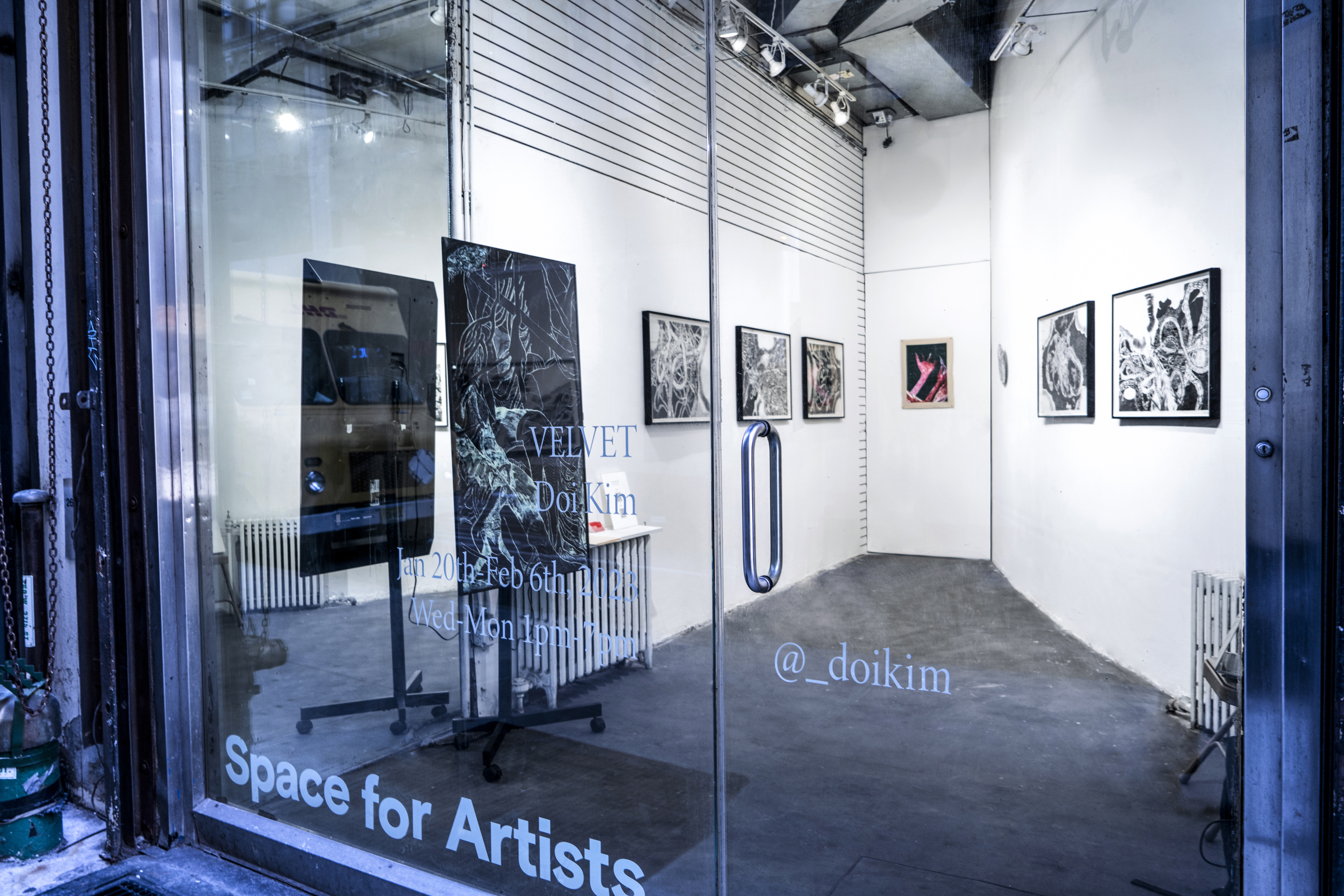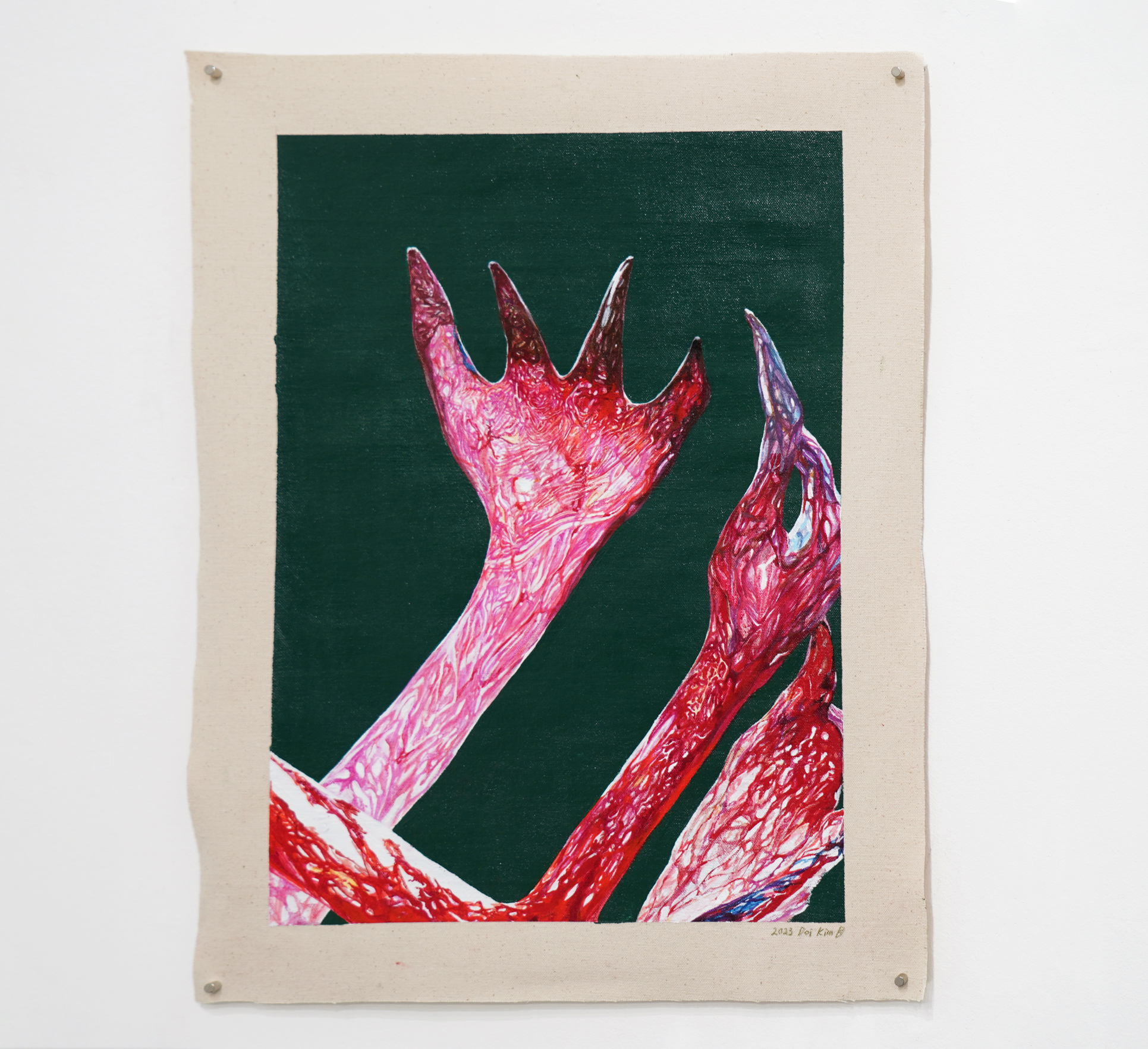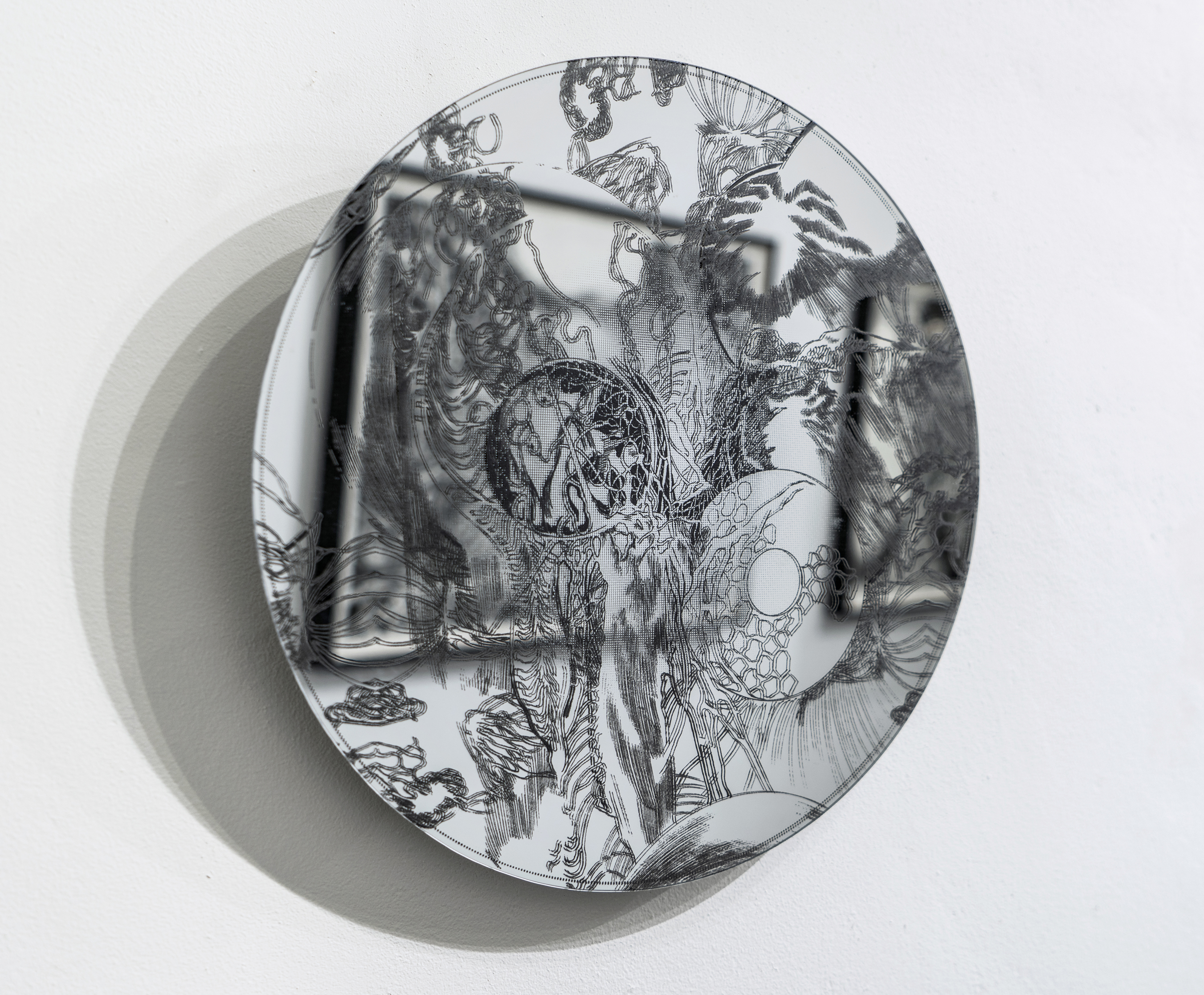Velvet
Doi Kim Solo Exhibition: Velvet
Venue
ChaShaMa Space (266 W 37th St, New York, NY 10018)
Exhibition Dates
January 20 - February 6, 2023
Curation: Doi Kim
Coordinator: Jiwoo Kim
Statement Editor: Media Farzin
Poster design: Doi Kim
Space design: Sooin Kim, Doi Kim
Installation: Doi Kim, Juhye Lim, Edmund Lee, Joony Kim
Documentation: Doi Kim, Madeline Mancini
Sponsored by ChaShaMa
Special thanks to ChaShaMa, Media Farzin, Sooin Kim, Juhye Lim, Edmund Lee, Joony Kim, JiYoung Kim, Madeline Mancini, and Felix Harlan.
김도이 개인전: 벨벳
전시 장소
ChaShaMa Space (266 W 37th St, New York, NY 10018)
전시 기간
2023년 1월 20일 - 2월 6일
기획: 김도이
코디네이터: 김지우
스테이트먼트 감수: Media Farzin
포스터 디자인: 김도이
공간 디자인: 김수인, 김도이
설치: 김도이, 임주혜, Edmund Lee, Joony Kim
촬영: 김도이, Madeline Mancini
공간 후원: ChaShaMa

Doi Kim: Velvet
Doi Kim’s solo exhibition, Velvet presents works that contemplate our complex relationship with personal and collective traumas through metaphorical storytelling. This exhibition is inspired by the velvet covering a deer’s antlers: a thin layer of skin concentrated with blood vessels and nerves that carry nutrients necessary for the antler’s growth and protection. A deer’s antlers are used primarily for defensive measures, but they are also a symbol of strength and dominance, a sign of the deer’s hierarchical standing in their social group. If a deer is malnourished, injured, or stressed, blood drains out of the antlers, and the velvet layer dries and peels away, revealing the mature antler underneath.
The exhibition invites viewers to imagine moments when their own “velvet” is “shed” in traumatic experiences. For instance, her painting Antler (2022) depicts the bleeding antler, shedding velvet and revealing the hardened core. It provides an entry point that leaves a clue to reflect upon how various levels of traumatic experience impact us. Kim’s virtual landscapes, depicted in animation, printmaking, and painting, invite viewers to look at personal and collective trauma differently. Her work seeks to connect various levels of “macroscopic” histories with present-day lives, to embody new perspectives on generational pain, and to consider how new insights on trauma might transform our present and future.
Velvet encourages viewers to re-envision the power dynamics of their personal lives and the broader geopolitical landscape, establishing a relationship between past and present from an individual’s perspective.
김도이 개인전: 벨벳은 은유적인 스토리텔링을 통해 다양한 층위의 트라우마와 개인의 복잡한 관계를 표현한다. 성장 중인 사슴 뿔을 덮고 있는 벨벳은 뿔의 성장에 필요한 영양분을 운반하는 혈관과 감각을 곤두세워 약한 뿔을 보호하기 위한 신경이 집중된 얇은 피부와 같은 장기이다. 이 벨벳은 호르몬의 변화에 따라서나 사슴이 영양실조, 부상 또는 과도한 스트레스로 더이상 뿔을 자라게 할 양분을 공급하지 못할 때에 탈각된다. 이때 벨벳 층에서 피가 빠져나가고 건조되어 벗겨지면서 외부 공기와 닿아 성숙한 뿔이 완성된다. 사슴의 뿔은 주로 방어 수단에 사용되지만, 무리에서 사슴의 계층적 위치의 표지, 즉 힘과 지배의 상징이기도 하다.
전시 벨벳은 관람객들로 하여금 고통스러운 경험 속에서 그들 자신의 "벨벳"이 탈각되는 순간들을 상상하도록 초대한다. 예를 들어, 회화 작품 Antler (2022)는 벨벳이 탈각되어 드러난 피에 절은 뿔을 묘사하는데, 이는 고통스러운 경험이나 기억이 개인에게 어떤 영향을 미치는지 상상할 수 있는 이미지를 제시한다. 이어 원자력 발전소 사고에서 영감을 받아 수세대를 거쳐 영향을 미치는 거시적인 트라우마를 은유하는 영상 작품인 바스커빌의 개 (2018~2023), 모자이크 시티 또는 문화의 용광로라고도 불리는 뉴욕에서의 경험에서 비롯해 유전 정보와도 같이 계승되는 거시적이면서도 사적인 사회 집단의 트라우마를 은유하는 다섯번째 아이 연작 (2020) 등을 통해 구축된 사변적인 서사는 관람객으로 하여금 집단적이거나 개인적인 트라우마를 인식하고 다르게 보도록 초대한다. 이와 동시에 직접 몸으로 느끼는 미묘한 관찰의 순간, 생생한 현재의 순간을 인식하도록 하는 실크스크린 작품인 풍경:렌즈 (2019~2020) 연작은 과거가 구속하는 현재의 공간에 균열을 낸다. 다층적인 트라우마에 대한 관점을 구현하며 각각의 이야기를 담고 있는 작품들은 삼각형의 전시 공간이라는 물리적인 조건에 따라 완고한 결말 없이 이어지며 반복된다.
판화, 드로잉, 영상, 회화 작품으로 구성된 전시 벨벳의 내러티브는 깊은 내면의 고통과 그 원인 또는 여파에 대한 새로운 관점을 찾고 그것이 우리의 현재와 미래에 어떤 영향을 미치는지에 관찰하기 위해 과거와 현재를 연결한다. 이러한 성찰과 숙고의 과정을 통해, 전시 벨벳은 관람자로 하여금 마치 역동적으로 뿔을 성장시키고 변화하는 장기인 벨벳과도 같이 그들의 개인적 삶의 힘의 역동성뿐만 아니라 더 넓은 지정학적 풍경을 다시 상상하도록하여 개인의 관점에서 과거와 현재, 집단과 개인 사이의 관계를 재설정하며 삶을 받아들이는 다양한 방식을 상상하도록 한다.

The Hound of the Baskervilles (2018-2022)
Entering the exhibition, the video work The Hound of the Baskervilles (2018-2022) shows a loop of the image of the life of a hound-like creature. The detective novel The Hound of the Baskervilles, by Conan Arthur Doyle, begins with the story of the monster dog that kills the successor of the Baskerville family. In my work, the hound is a metaphor for transgenerational trauma. I am also inspired by the Fukushima nuclear disaster and its ramifications.
The image in the video refers to a stylized form of medieval painting used in Giotto's frescoes,, which depicts events from different periods in one image, not a scene that takes place at one point. In the video, a four-foot monster appears – moving somewhere – and a couple of monsters and their offspring stare at the opposite side as they reminisce. The last scene connects to the first scene and repeats, like the unpromising wait that half-life for radioactive decay requires.
The infinite loop of the images expresses the time and space of an endless loop of suspended life, reproducing death itself. My aim is to propose clues about how transgenerational trauma is inherited and affects the descendants.




The Hound of the Baskervilles (still), 2018 - 2022, Animation, 4 minutes 2 seconds
The Fifth Child (2020)
The Fifth Child (2020), named after Doris Lessing's 1988 novel, is a series of five lithograph prints. Each print depicts a speculative landscape in which an embryo faces the trauma of former generations while they are in their mother's womb. It also visualizes the birth of a character who can bring chaos to current social situations, a bold new identity who can challenge conservative tellings of history.
The Fifth Child (2020) was inspired by my encounters with the cultural landscape of New York in 2019 when I first moved to the city. I observed that historic trauma forms the basis of many collective identities and shapes the city's geopolitical landscape. It made me think of how each individual aligns or builds their values amid the environment of intense interaction.
In Lessing's novel, The Fifth Child, Ben, the dysfunctional fifth child of the family, gives pain to his parents from pregnancy, eventually destroying their conservative fantasies of a perfect traditional family. Reflecting upon the novel and by taking on the role of an outsider, I explore the individual and collective experiences through the eyes of an unborn being, envisioning a speculative scenario of the birth of a character who can bring chaos to current social situations.Each lithograph depicts the stage of development of an embryo, visualized using botanical and anatomical images:
The Fifth Child 1 shows an image of umbilical cords.
The Fifth Child 2 illustrates the formation of internal organs.
The Fifth Child 3 implies the formation of a fictional character affected by transgenerational trauma by depicting the image of DNA structure.
The Fifth Child 4 visualizes the formation of a fetus's muscle inside the mother's womb.
The Fifth Child 5 illustrates an imaginary being ready to break out of the womb and be born into the unknown world.
The trauma of the former generation is expressed as intense light, inspired by the dramatic use of chiaroscuro in baroque paintings.
To learn more about The Fifth Child (2020), click here



Landscape: Lens (2019-2020) and Antler (2023~)
If the two bodies of works described above stated the impact of the past and speculation about the future, Landscape: Lens (2019-2020) accentuates the viewer's physical presence in the exhibition, making them aware of the present moment. Images on the mirrors are landscapes consisting of the anatomical images of the eye, such as the optic nerve, vitreous body, and retina. This work draws subtle movements of eye muscles that occur when viewers focus on the image of the work and change their focus on themselves in the mirror. The drawings on the mirrors serve as a medium, like a lens, to make the viewer aware of the moment of observation, continuously contracting and releasing the muscle around their iris.
Antler 1 (2023) depicts the bleeding antler, shedding velvet and revealing the hardened core. Antler is a clue for reflecting on how various levels of traumatic experience impact us, and stresses the belief that our cells and perceptual states are dynamic and changeable, suggesting a unique way of accepting life.





Altogether, the exhibition “Velvet” challenges viewers to reflect on their own experiences while inviting them to look at trauma in a different light, with curiosity. In this way, the exhibition provides a unique opportunity to connect with both history and the present moment in order to find a new perspective on deep-seated pain and its effects and gain insight into how it might affect our present and future. Through this process of reflection and contemplation, Velvet encourages viewers to re-envision the power dynamics of their personal lives as well as the broader geopolitical landscape, establishing a relationship between past and present.

© Doi Kim 2023